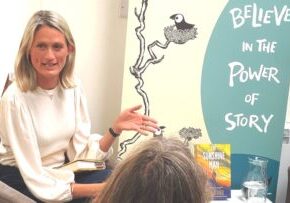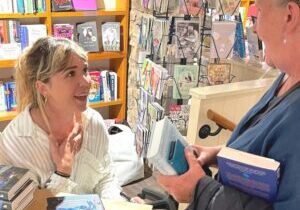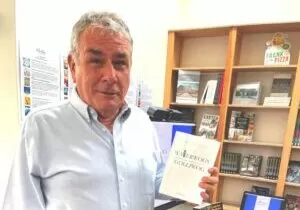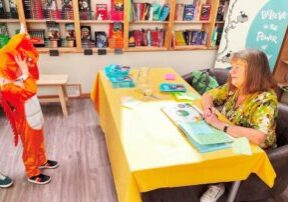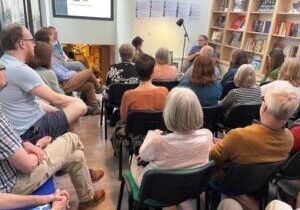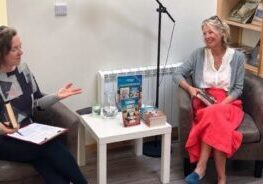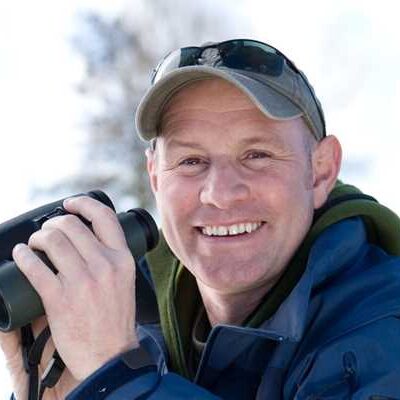
One Thousand Shades of Green follows The One Show’s wildlife expert Mike Dilger on an epic mission to see one thousand different species of plants in Britain in 2021. Ahead of our event next week, here’s a little interview with Mike about flora, family and more by our friends at Booktime.
The book is about your search for a thousand plants around Britain. Do you think that plants are often forgotten when people think about the natural world?
Absolutely. I started off as a birdwatcher. I did a degree in botany, but that doesn’t necessarily teach you how to identify plants. There’s thing called plant blindness where people don’t actually look at plants. They’re the bed and breakfast of birds, invertebrates and mammals but no one looks at them properly. They’ll look at a bird when they’re perching on a tree, but they might not know what the tree is. It’s astonishing really that the RSPB has 1.1 million members, but Plant Life and the Botanical Society of the British Isles have a few tens of thousands.
My wild idea, when coming out of lockdown, was to try and see a thousand plant species in a year. It came from when we were locked down and only allowed out half an hour. I was out with my boy, walking in the lanes around my house. I knew all the birds, I knew their calls, so I started looking at the plants at my feet. From there it just mushroomed, and I became utterly obsessed. When we came out of lockdown, I could spread my wings a bit further afield and see lots more stuff. So, yes, a lot of people don’t look at plants and I think it’s frankly criminal!
In the book, you often involve your wife Christina and your son Zachary. Did you see it as a family project?
Absolutely! It was only me who saw the thousand plants, because my family weren’t always with me. But, wherever possible, I tried to include them. It was a family affair, and they really brought something to the table. My wife works as a freelance gardener, so she can identify the weeds that had escaped over the garden wall. And my boy being nine, he’s closer to the ground, and also he’s got fantastic eyesight. So, he was saying ‘What’s this daddy, what’s that?’. We also took our dog, a border collie called Bramble, who had this amazing knack of weeing on interesting plants! We went on holiday down to Cornwall, to the famous Lizard Peninsular which is one of the most important sites in Britain, and it was a holiday of half beach, half looking for rare plants. Sometimes I went slightly over the top and did a little bit too much, but they made sure they told me about that!
“The book isn’t just about plants, it’s about people”
How did you connect with the many conservationists you met along the way?
The book isn’t just about plants, it’s about people – both my family and the people I met. Some of them were old friends – my old university professor was. a good example, and a mate of mine who used to work in conservation. We met up and would go botanising together. It was a bit of a ‘Friends Reunited’ situation, to use an old social media reference! I also met new people via my conservation and TV contacts.
How does writing books compare with your TV work?
They are very complementary. With TV, they’ll say ‘you’re filming tomorrow,’ or ‘you’re filming next week’ and you have to drop everything. The great thing about writing is that you can slot it around things. It’s a movable feast. I find it really, really hard, and I’m really slow. I’m much better at editing than writing. Once I’ve got something down on paper, crafting it and recrafting it is what my real strength is. The great thing about it, is that it enables me to be at home. With my TV work, I’ve away about four months of the year.
How did you write the book, did you take notes while you were travelling?
I did, I had a really detailed list of exactly what I saw, where and when, and anything else interesting about it. I didn’t really keep a diary, but on my phone I had a list of notes. And in the evening, I’d put the plants into a big spreadsheet on my laptop, with lots of details. As soon as I used the spreadsheet with my notes, it would all come flooding back. Then I sat down and wrote it in one big splurge.
Of all the plants you found and the places you visited, which was your favourite?
Seeing my thousandth plant with my family was pretty memorable. It was a very rare plant called goldilocks aster, and it was halfway up a cliff-face. But probably the best plant was one called Norwegian mugwort, which only grows on three mountaintops in the Highlands. I went up there with an amazing botanist called Barbara Jones, and I made a Radio 4 documentary, Costing the Earth. We were right on top of the mountain, it’s arctic tundra, with hardly any vegetation, and then we saw this amazing little hairy plant with a little flowerhead like a yellow smartie. We went through the rain and fog and midges, and popped up into blue sky. It was a beautiful moment, I shed a few tears.
One Thousand Shades of Green by Mike Dilger is published by Bloomsbury Wildlife
You can find out more about our event with Mike Dilger on Wednesday February 22nd here.
February 15, 2023
Blog > Interviews > Mike Dilger



